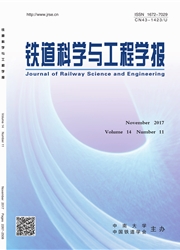

 中文摘要:
中文摘要:
锅炉钢结构大板梁对接焊接接头在施工及运营中,会产生裂纹缺陷.为了评怙在役大板梁对接焊接接头的钢材性能,并为基于断裂力学的大板梁焊接缺陷安全性评定提供基础数据.通过真实模拟构造华东某电厂锅炉大板梁120 mm厚 Q345B下翼缘厚板对接焊接接头,结合单轴拉伸、低温冲击和三点弯曲断裂韧性试验,研究了该构造焊接接头母材、热影响区及焊缝处的基本力学性能、冲击韧性和断裂韧性.研究结果表明:母材和热影响区钢材力学性能稳定,而焊缝处力学性 能指标离散性偏大:随温度降低,母材、热影响区及焊缝处钢材冲击功值减少:焊缝处的韧- 脆转变温度较高、 CT0D特征值较小,韧性性能较差.厚板对接焊接接头的焊缝区成为防断设计和评怙的重点控制区域.
 英文摘要:
英文摘要:
During construction and operation, crack defects can be induced in the welded joint of big plate girder deployed in boiler steel structures. In order to evaluate the material properties and to offer basic parameters for the safety assessment method, based on fracture mechanics, of welding defects of the in-service big plate girder, the simulated welded joint was made according to that of the lower flange plate of big plate girder employed in an East-china power plant. Mechanical properties, impact toughness and fracture toughness were investigated for steel materials located in base metal, heat - affected zone and butt weld of the simulated welded joint respectively, by conducting the uniaxial tensile tests, Charpy V-notch tests and three-point bending tests. Re-sults indicate that materials of base metal and heat-affected zone show stable mechanical properties, whereas the mechanical indices of butt weld exhibit greater dispersion. Charpy impact energy reduces with the decrease of temperature. Compared with base metal and heat-affected zone steel, the ductile-brittle transition temperature of the butt weld is higher and its CTOD value δm is lower, implying the worse toughness performance. In summary,more attention should be allocated to the weld zone of the thick-plate welded joint during its fracture resistant design and evaluation.
 同期刊论文项目
同期刊论文项目
 同项目期刊论文
同项目期刊论文
 期刊信息
期刊信息
